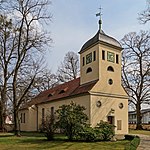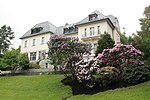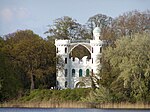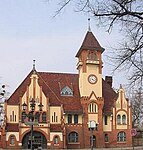The American Academy in Berlin is a private, independent, nonpartisan research and cultural institution in Berlin dedicated to sustaining and enhancing the long-term intellectual, cultural, and political ties between the United States and Germany. Each year, the Academy's independent search committee nominates circa twenty fellows from among hundreds of applicants to pursue semester-long research projects at the Hans Arnhold Center, a historic villa on the shores of Lake Wannsee. Fellows, who come from the humanities, social sciences, public policy, and the arts, share their work with German colleagues and audiences at lectures, readings, discussions, concerts, and film screenings, which form the core of the Academy’s program of nearly 100 public events per year. The American Academy in Berlin has an office in New York City and its board of trustees is composed of several dozen influential leaders from German and American business, finance, culture, and academia.
In addition to its fellowship program, the Academy fosters dialogue on current issues by hosting Distinguished Visitors—thought-leaders from the United States in public policy, law, business, finance, journalism, the humanities, and the arts. During their visits of a few days to a few weeks, they engage with the public and their professional counterparts in Berlin and throughout Germany on topics ranging from constitutional law and immigration policy to museum practice and art criticism. Since 1998, the American Academy in Berlin has hosted nearly 500 residential fellows and hundreds of Distinguished Visitors.
The American Academy in Berlin was founded in September 1994 by a group of prominent Americans and Germans, among them Richard Holbrooke, Henry Kissinger, Richard von Weizsäcker, Fritz Stern, and Thomas Farmer. Dubbed in 2008 “the world's most important center for American intellectual life outside the US” by the German weekly magazine Der Spiegel, the American Academy in Berlin is funded entirely by private donations from individuals, corporations, and foundations on both sides of the Atlantic—most prominently the Arnhold-Kellen family, the keystone of the Academy's history and funding.
The Wannsee villa that houses the American Academy in Berlin, designed in 1886 by architect Johannes Otzen, was once the home of chemist Franz Oppenheim and, later, the Dresden-born banker Hans Arnhold and his wife, Ludmilla, and their two daughters, Ellen Maria and Anna-Maria. After the Arnholds were forced to emigrate, in 1937, the house was appropriated and occupied by Walther Funk, the Minister of Economics of the Third Reich and later president of the Reichsbank.
The Arnhold family regained ownership of the home in 1953, and the villa was sold to the Federal Republic of Germany in 1958. During the post-WWII tripartite division of the Berlin, the villa was located in the American Sector. There, it was designated for various uses, including as a home for refugees from communist Eastern Bloc countries and, for the last decades of the Cold War, a U.S. Army recreation center, until the departure of American military forces from reunified Berlin, in 1994.
Following a thorough renovation of the building, made possible by the financial backing of the Arnhold-Kellen family and a number of other supporters, the villa opened as the American Academy in Berlin in 1998.












